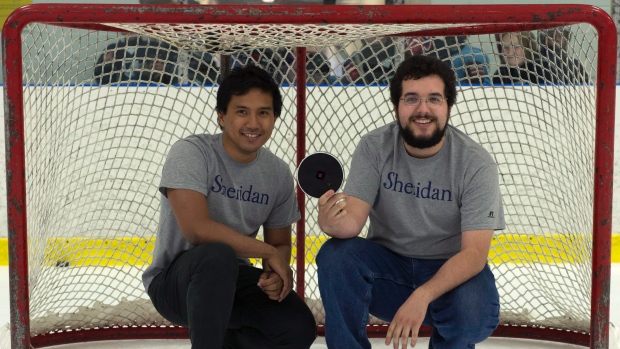[VIDEO] Canadian students create puck for visually impaired players
File this under amazing.
The Canadian Press has reported that two Sheridan College (Toronto) students have created an audible puck that can be used by visually impaired hockey players.
And if you’ve never thought about visually impaired hockey, then you may be surprised it exists in both the United States and Canada.
But one of the biggest challenges is having a proper puck. And it took two engineers, who weren’t very familiar with hockey, to offer the best audible puck to date.
More:
They say it’s proven difficult to find a puck that can be heard equally well while stationary or in motion, adding that ice temperatures and arena acoustics add further challenges.
The Sheridan College classmates, however, say those very issues prompted them to redesign their puck three times in the last five months. The pair took first place in the re-engineered products category at the IAM3D challenge in Boston.
The audible hockey puck was among 20 finalists for this year’s competition and was up against three other entries from fellow Sheridan students.
The team behind the project may seem an unlikely choice to spearhead the latest effort to develop a puck.
Ryan Vieira said he and his fellow student Kristoffer Pascual, who are both fully sighted, had little interest or familiarity with hockey when they took on the project. Nor were they influenced by the myriad previous designs that had fallen in and out of favour for at least the past 40 years.
“I was always into it for the challenge,” the 23-year-old said in a telephone interview. “I had no design to work off. I was just given a basic shape and what it had to do.”
And the challenge was not easy. It is not only about the audible nature of the puck (in arenas with oftentimes poor acoustics) but also the size and speed.
But the two students were able to finalize a design:
Vieira and Pascual had to go through two prototypes before settling on the design they’ll present in Boston. Previous incarnations were made of plastic that grew too brittle when exposed to the ice, contained circuit boards that fell apart upon impact with a stick, or featured speakers that didn’t project sound out towards the players and were also susceptible to damage during play.
The final product, produced in the 3D printing lab at Sheridan, consists of nylon top and bottom inserts surrounded by aluminum casing. The internal buzzers emit tones that Vieira likens to the sound of an alarm clock, and are powered by a nine-volt battery.
With a diameter of 14 centimetres, a height of five centimetres and a total weight of about 600 grams, the Sheridan design comes close to what Courage Canada describes as the ideal dimensions for a puck for the blind.
Regardless of this weekend’s first place honours this weekend, Morrow said the true test will come when blind players put it through its paces in an actual game. Only then, he said, will the team truly know whether their design reaches its goal — or needs to be put on ice.
So what is it like on the ice?
Image courtesy of the Canadian Press.



